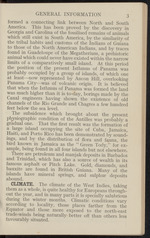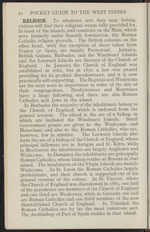| 1 |
 |
“...was
probably occupied by a group of islands, of which one
at least—now represented by Ancon Hill, overlooking
Panama City—was of volcanic origin. It is believed
that when the Isthmus of Panama was formed the land
was much higher than it is to-day, borings made by the
Canal engineers having shown the existence of old
channels of the Rio Grande and Chagres a few hundred
feet below the sea level.
The subsidence which brought about the present
physiographic condition of the Antilles was probably a
gradual one. That the first result was the formation of
a large island occupying the site of Cuba, Jamaica,
Haiti/ and Porto Rico has been demonstrated by sound-
ings, and by the distribution of flora and fauna, the
bird known in Jamaica as the 11 Green Tody,” for ex-
ample, being found in all four islands but not elsewhere.
There are petroleum and manjak deposits in Barbados
and Trinidad, which has also a source of wealth in its
famous asphalt or Pitch Lake. Gold, diamonds, and
bauxite are found, in...”
|
|
| 2 |
 |
“...provided for.
In most of the islands, and countries on the Main, which
were formerly under Spanish domination, the Roman
Catholic religion prevails. The British colonies on the
other hand, with the exception of those taken from
France or Spain, are mainly Protestant. Jamaica,
British Guiana, Barbados, and the Windward Islands
and the Leeward Islands are dioceses of the Church of
England. In Jamaica the Church of England was
established in 1662, but in 1870 a law. was passed
providing for its gradual disendowment, and it is now
practically self-supporting. The Baptists and Wesleyans
are the next sects in importance in order of the size of
their congregations. Presbyterians and Moravians
have a large following, and there are also Roman
Catholics and Jews in the island.
In Barbados the majority of the inhabitants belong to
the Church of England, which is endowed from the
general revenue. The island is the see of a bishop, in
which are included the Windward Islands. Small
Government grants are...”
|
|
